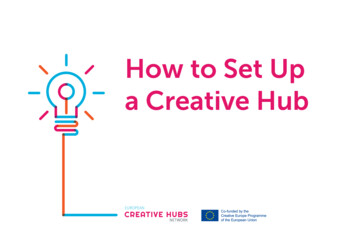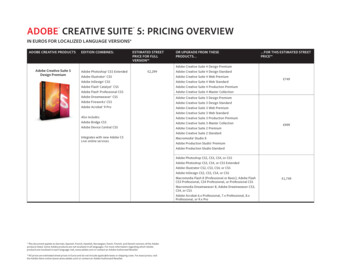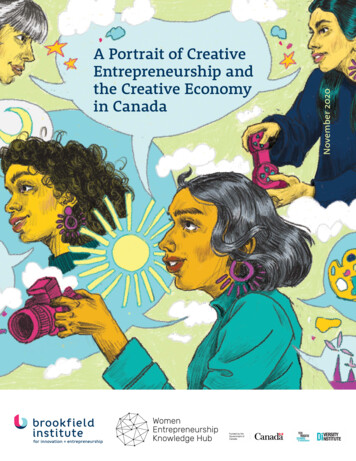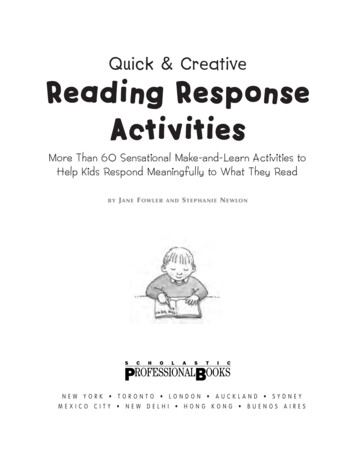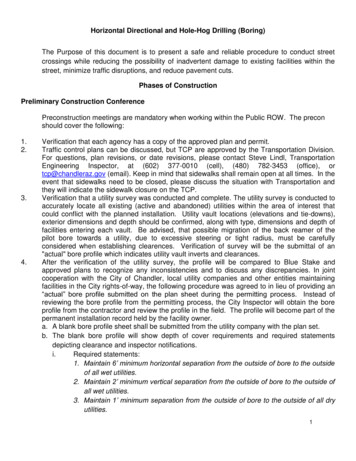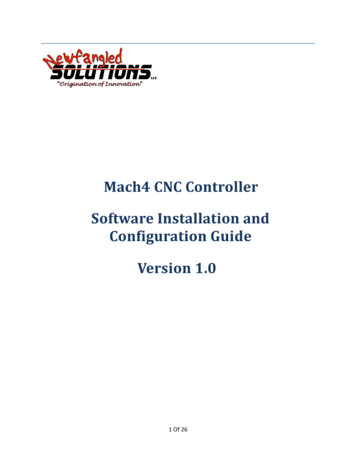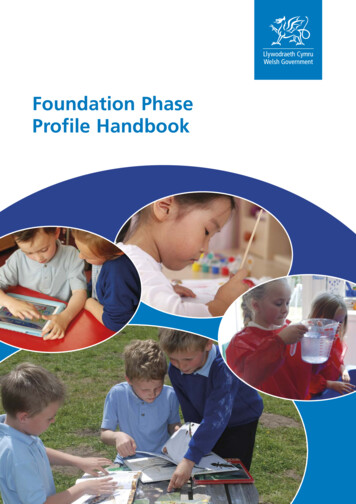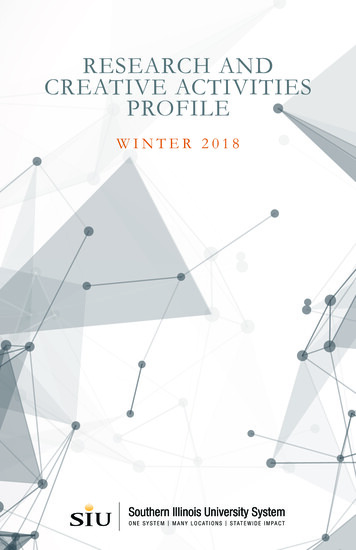
Transcription
RESEARCH ANDCREATIVE ACTIVITIESPROFILEWINTER 2018
CHICAGO & LAKECOUNTY PROGRAMS
The general public is often curious whether it is worthwhile for faculty toengage in the pursuit of academic research. The underlying implication is thatthere is minimal importance in undertaking such scholarly inquiry – unlessthere is a tangible product or direct benefit to those making the query. Asyou might guess, this assumption shows that there is a lack of knowledgeregarding what research is and the value that it brings to the institution and thelarger society. Consequently, higher education leaders must find a way to moreeffectively communicate to external stakeholders the immeasurable benefits offaculty (and student) research.Over the years, I knew that Southern Illinois University was a strong researchinstitution with a well-deserved national reputation. However, only recentlydid the significance of its scholarly research really stand out to me. Specifically,in 2017 the Milken Institute ranked SIU as #72 in the country for technologytransfer and commercialization. Notably, SIU outranked some very prestigiouspublic/private universities – including Big Ten and Ivy League institutions.In this edition of Research and Creative Activities Profile, we focus only on aselect number of University research projects that represent the approximately 83 million in grant dollars received annually. Thus, not only does SIUresearchers’ work enhance such areas as the arts, medicine, education, andthe sciences, but externally funded grants comprise almost 10 percent ofSIU’s total annual budget. This allows the hiring of countless graduate (andundergraduate) students who commit to study at SIU solely because of theresearch conducted in a particular academic discipline.In sum, the Profile helps answer the “value of research” question as well asshows the different types of research and its accompanying benefit. On behalf ofour faculty and students, thank you for supporting the research mission of SIU.Brad Colwell, Ph.D., J.D.Vice President for Student & Academic AffairsSouthern Illinois University System
SIU RESEARCHER DISCOVERSCAUSE HIGHER FLOODSBy Tim CrosbyFlood control engineering along the Mississippi River during the lastcentury has caused floods to increase in magnitude when they dohappen, according to an article published earlier this year in a leadingscientific journal that was co-authored by researcher Jonathan Remo.In the article, published in the journal Nature, the authors argue thatclimate patterns, such as El Niño and others, also strongly affectflooding trends. But changing the river’s channels, through confiningit with levees, has greatly amplified flooding when it does occur.Remo, associate professor of geography and environmental resourcesand director of the Environmental Resources and Policy doctoralprogram jointly run by SIUC and SIUE, co-authored the article onthe study, which examined the physical record for the last 500 yearsof flooding along the river. The researchers focused on the river fromCairo, Ill. south to Vicksburg, Miss.CENTURIES OF FLOODS REVEALEDBY TREE RINGS AND SANDThe researchers used a technique known as paleoflood reconstructionto gain information about flooding from before records were kept,stretching back to 1500.The methods involved examining sand left behind by the river infloodplain lakes during flooding events centuries ago. Using radiocarbon dating techniques, researchers were able to tell the age of theorganic material that accumulates on top of each new sand depositleft by a flood, giving them a relative date for each flood.
FLOOD CONTROL EFFORTSSIU GEOGRAPHY FACULTY MEMBERCONTRIBUTES EXPERTISEAn expert in flooding and river management, Remo contributedfurther to the project by using knowledge gained from a nearly 300,000 National Science Foundation-funded study that examinedthe flooding record left behind in tree rings along the MississippiRiver and its principal tributaries.His method involved taking core samples from trees that in somecases are more than 300 years old and examining the sample undera microscope. Once those flood years were established, they werecompared to the carbon-dated sediment samples, further confirmingthe accuracy of the methods.“Some of the trees date back to the latter half of the 1600s to the1700s, many of them located in the Missouri bootheel,” Remo said.“When you look at the sample under a microscope, the years thatinvolved flooding have different shape than other years.”FLOOD CONTROL ATTEMPTS HAVEUNINTENDED OUTCOMESRemo said during the last century flood protection engineering hasincreased the magnitude of flooding once those systems are breachedbecause they make the water run higher.“So the flooding is worse when it does happen,” he said.Remo said the study’s findings give policy makers and scientists amuch better picture of flood variability along the Lower MississippiRiver.“I hope the information will help us ensure our flood mitigationsystems are able to protect us from current and future floodhazards,” Remo said.
COLLABORATIVEINTERNAL GRANTPROGRAM BUILDSBRIDGESAn internal grant program isgiving SIU scientists, researchers,and students the opportunity tobuild valuable collaborations withcolleagues across the SIU System.
The idea began after Susan Morgan, PhD, SIUE associate dean for researchand graduate studies in the Graduate School and professor in the Departmentof Civil Engineering, contacted School of Medicine (SoM) AssociateDean of Research Linda Toth, DVM (now retired), to discuss SIUE’s NIHBiomedical/Biobehavioral Research Administration Development (BRAD)grant to support infrastructure for health-related disciplines. Toth suggestedan internal grant program to increase faculty collaboration. The program waslaunched in 2016 with SIUC joining in 2017.For the Collaborative Internal GrantProgram, each campus can contributeup to 10,000 in support for a chosenresearch project. At least two PrimaryInvestigators from different campusesmust be involved, but a project can haveinvestigators from all three campusesand thus be eligible for 30,000 total. Acommittee comprised of faculty fromeach campus reviews the applications.“The three associate deansfor research emphaticallysupported this initiative lastyear, and do so even moretoday.”Don Torry, Ph.D andSoM Interim Associate Dean for ResearchSince the program was initiated, three teams have received awards: Traves Crabtree, MD, Department of Surgery at SoM, and TimothyYork, PhD, in the SIUE Department of Electrical and ComputerEngineering, designed a novel camera system for video-assisted thoracicsurgery. James Daniels, MD, Department of Family and Community MedicineQuincy, SoM, and Lindsay Ross-Stewart, MD, SIUE Department ofApplied Health, studied the effects of imagery-assisted virtual reality(IVAR) on geriatric patients after a hip or joint replacement. Daotai Nie, PhD, Department of Medical Microbiology, Immunologyand Cell Biology, SoM, and Bill Neumann, PhD, Department ofPharmaceutical Sciences, SIUE, gathered new data on a sigma receptorsubtype that has been found highly expressed in malignant cancer cells.Neumann believes the NIH-style proposal template, review process andevaluation reports offer a trial run for external grant seeking. “It makesit very easy to turn the proposal into an external submission, which wehave already done with the Department of Defense,” he said.SoM Interim Associate Dean for Research Don Torry, PhD, is a fan ofthe system-wide program and the message it sends. “The three associatedeans for research emphatically supported this initiative last year, and do soeven more today,” he said. “All three offices feel that research is part of themortar that transcends any differences, unites us together, builds internalcollaborations and hopefully can further develop and synergize our researchexpertise between the campuses.”
FROM PAS S I VE T E L E ROB O T I CPL AT FORM S T O I N T E R AC T I V E ,TA NGIB L E HU M AN RO B O TINT E RFACE S“I have been part robot since May. Instead of legs, Imove on gyroscopically stabilized wheels. Instead ofa face, I have an iPad screen. I am a remote worker.”This excerpt from WIRED magazine, September 2015, brought to light oneof the ongoing and most challenging facets for humans using telepresencerobots – the social experience, or lack thereof. The article described thefrustration associated with the inability to socialize with coworkers –specifically not having arms and hands for interacting with colleaguesthrough handshakes or gestures – and inappropriate “robot touching” (e.g.colleagues picking up the platform and moving it without warning).KEYDEFINITIONS:REMOTEUSER:The individualcontrolling thetelepresenceplatform remotelyLOCAL USER:Those in contactwith thetelepresenceplatform“While telepresence robots are enabling newheights of remote communication, challengesstill exist for both local users and remote users increating the social dynamic of connectedness,”said Jerry Weinberg, PhD, associate provost forresearch and dean of the SIUE Graduate School.“The ability to talk with our hands, somethinghumans do so eloquently in conversation,enables us to connect and relate on a deeperlevel,” Weinberg said. “This intuitive, nonverbalcommunication is currently absent in thetelepresence experience.”With funding from a three-year National ScienceFoundation (NSF) Cyber Human Systems grantand a recent NSF Research Experiences forUndergraduates grant, Weinberg is collaboratingwith colleagues to bring the tangible and social experiences that connectindividuals in conversations to mobile telepresence platforms.Weinberg, a professor of computer science, is working with SIUE alumnaJenna Gorlewicz, PhD, assistant professor of mechanical engineeringat Saint Louis University; Mitsuru Shimizu, PhD, assistant professor ofpsychology at SIUE; and students from both universities.
LEARN MORE AT SIUE.EDU/RESEARCHAn expert in humanmachine interfaces,Gorlewicz and herstudents have designed alightweight, ergonomicarm that can interactin typical social ways,specifically extending fora handshake, gesturingwith hands and pointing.Using an Xbox Connect,Weinberg and his studentshave created softwarewhich enables the remoteuser to talk with theirhands.“We don’t want to addan additional technologybarrier.” Weinberg said.“The Xbox Connectwill pick up the naturalmovements of the remote userand, using a complex algorithm,translate them to the movement ofthe robot arm.”Jerry Weinberg and Jenna Gorlewicz do a test runwith James Slack, Saint Louis University Alum.Once the technology has been perfected, Shimizu will begin user studies totest the level of social connectedness. Testing will include human subjectsinteracting with the robot to determine how well the local user sociallyconnected to the remote user through the enhanced robot interactions.Testing the reverse, where the human subjects control the robot, willdetermine how connected the remote user feels to the local user while usingthis technology.“Our hope is that the social connection is both ways,” Weinberg said. “Wehope our research will open up pathways for new levels of remote socialexperiences and enriched human-robot interaction among individuals innumerous settings across the world.”
PO I N T S O F PRI DEDRONES MAY HOLD1 KEY TO FIGHTINGWith the demand for foodhigher than ever, farmers donot have time to strugglewith plant diseases and cropfailures. New solutionsoften emerge to improvethese problems, butmore progress is stillnecessary.Farmers areexperimenting withprecision agriculture– using informationtechnology for mapping andspraying. This technique frequently employsunmanned aerial vehicles (UAV), commonly known as drones, to ensurethat crops receive exactly what they need for optimum health.Lindsey McKinzie, a first-year graduate student studying plant soil and agriculturalsystems, is hard at work using drones to find new solutions. She spent this summerworking with faculty to study the rate of diseases in row crop plots and experimentwith the usefulness of UAVs.By using drones to evaluate fields, the team at SIU hopes to make farms moreefficient, cutting down on the estimated 30 to 40 percent of produce fromcultivated plants that die each year from diseases.The researchers use a rating system that estimates the severity of disease in a crop,using drones as their “eyes.” The process includes flying the drones over the fieldsand taking pictures of the plants. The team then compares the UAV data with theground-collected data to determine the effectiveness of the drones, and later, tomanage the health of the fields.Photo by david henrichs on UnsplashCROP DISEASE INTHE FUTURE
NIH GRANT FUNDSCHLAMYDIA RESEARCHMicrobiologist Derek Fisher and chemist Kyle Plunkettare teaming up to fight the scourge of chlamydia.The two SIUC associate professorsrecently received a second round offunding from the National Institutesof Health, bringing the total to almost 860,000 since 2014 for the research.or better treat the sexually transmitteddisease that wreaks havoc on youngerpeople in the prime of their lives,resulting in infertility and in some caseslife-threatening conditions.Fisher and Plunkett, along with SIUCgraduate and undergraduate studentresearchers, are looking at a certainenzyme that “flags” proteins by addinga phosphate molecule to them, as wellas an enzyme that takes that moleculeaway. Such interactions – calledphosphorylation – if better understood,could potentially lead to new drugtherapies or vaccines that would preventFisher and Plunkett aim to find achemical means of interrupting thedisease, which relies on the lock-and-keyrelationships between certain proteinsand enzymes to grow and spread. Theresearchers are looking at how thebacterium first infects a healthy cell, aswell as how it replicates after doing so,and how it transitions between its twoforms.3 COMPUTER SCIENCE STUDENTWINS AWARD FOR ANTI-PIRACY APPYou might say Ayush Kohli hunts modern day pirates, and hisfield of battle is cyberspace.work recently garnered him a thirdMore than 85 percent of smartphoneplace award from the Association ofusers have selected an AndroidComputer Machinery’s (ACM) Studentoperating system, which gives access toResearch Competition world final, aa multitude of applications – almost 3million different apps, as of June 2017 – prestigious, international event.from the Google Play store alone.The world final featured the work of17 ACM student research competitionBut such a system provideschampions from different areas ofopportunities for pirates, in violationcomputer science, who came from topof intellectual property laws, to causeuniversities, including the Massachusettsmayhem by modifying popular appsInstitute of Technology, Harvard,from the unofficial marketplaces or byNorthwestern, Cambridge and theinjecting malicious code into apps theyUniversity of Southern California,upload to such marketplaces, or evenamong others. Kohli secured histhe Google Play store.place in this competition by receivingfirst place in the 2017 StudentKohli, an SIUE senior earning a degreeResearch Competition in the Softwarein computer science, has come up withEngineering area.what might be one of the best countermeasures available: DecisionDroid, asupervised learning-based system thatidentifies pirated Android apps. His2
PO I N T S O F PRI DE1A 300,000 grant from the Department of Justice through the ViolenceAgainst Women Act has enabled SIUE to expand its efforts to ensure students,faculty and staff feel they have a safe space to learn about, discuss and reportincidents of gender-based violence such as sexual assault, dating violence andstalking. Funds are supporting the SIUE Survivor Initiative, which has three goals: Prevent and reduce the incidence of sexual assaultexperienced by SIUE students Coordinate current and proposed efforts to respondto sexual assault committed toward SIUE students Increase awareness of and access to preventioninformation and victim’s servicesJim Klenke, associate vice chancellor for student affairs; Lindsay Serrano, SIUEcounseling services; Dustin Brueggemann, SIUE police lieutenant; and formerfaculty member Dayna Henry were the principal grant writers.2A 287,690 National ScienceFoundation ResearchExperience for Undergraduatesthree-year grant turned SIUE into asummertime hub for an innovative,interdisciplinary archaeological andecological research project that aimsto document deep-time anthropogenicimpact in the Upper Mississippi RiverSystem. The project, “ExploringEvidence of the Anthropocene:Archaeological and EcologicalInterdisciplinary Research Experiencesfor First-Generation Students in theUpper Mississippi River System,” isled by principal investigator CarolColaninno, PhD, assistant researchprofessor in the SIUE Stem Center,and co-PI John Chick, PhD, directorof the Great Rivers Field Station ofthe Illinois Natural History Survey,University of Illinois. Each summer,Colaninno and Chick mentor 10undergraduate students as theyparticipate in an immersive, eightweek research experience on the SIUEcampus and nearby Mississippi andIllinois rivers that guides studentsthrough the scientific process.Researchers at SIUE are developinga new system to identify risk ofcardiac events. The American HeartAssociation granted SIUE 154,000in support of the research, which isbeing led by Jon Klingensmith, PhD,assistant professor in the School ofEngineering’s Department of Electricaland Computer Engineering, whosebackground is in ultrasound signalprocessing and coronary imaging. Cocollaborators include Maria Fernandezdel Valle, PhD, assistant professorof exercise science in the Schoolof Education, Health and HumanBehavior, and H. Felix Lee, PhD,professor of industrial engineering inthe School of Engineering. The team isdeveloping a cost-effective system thatcould be widely deployed for accuratevolumetric measurement of epicardialadipose tissue.3
POINTS OF PRIDEU CLIN IC FI R S T T O S TU DY1 SIN E W HIG H BL O O D PR E S S U R ETRE AT M E N TOver 100 million Americans havehypertension, and more than half ofthose who are on high blood pressuremedications still don’t have their bloodpressure under control. Doctors atSoM are conducting a groundbreakingclinical trial to test the effectiveness ofa new device to lower blood pressure.The CALM-2 study is enrollingparticipants now.The clinical study is designed toevaluate an investigational device as apossible solution for patients whoseblood pressure is not controlled withprescribed medications. Participants inthe study will be among the first in theworld to undergo this investigationalimplant procedure, which is designedto reduce blood pressure after a singletreatment. The catheter-deliveredMobiusHD device is inserted in thebody in a similar way to heart stents.Once in place,it reshapes thecarotid arteryand triggersthe body’s“baroreceptors” – specialized nervesthat send amplified signals to the brainthat may lead to long-lasting controlof high blood pressure. VascularDynamics developed the device and issponsoring the research.SoM’s Springfield location was thefirst site in the world to enroll apatient in the randomized clinical trial.John M. Flack, MD, MPH, professorand chair of SIU’s Department ofInternal Medicine and president ofthe American Hypertension SpecialistCertification Program, leads theresearch team. Kim Hodgson, MD,chair of the Division of VascularSurgery, performed the procedure.K LIN G T H E O PI O I D2 TACE PI D E M ICThe national opioid crisis has farreaching effects, and rural regions likethe majority of SoM’s service area aredisproportionately affected by opioidaddiction. During the past year, twoSIU departments have been workingdiligently to help curb the crisis.In partnership with the Office ofRegional Programs, SoM’s Departmentof Psychiatry has developed acurriculum for opioid prescribers inthe 66-county region. DepartmentChair Kari Wolf, MD, and an advisorycouncil have coordinated video-conferencedtraining andcontinuingeducationcredits forboth live andtaped training at various locationsin the SIU service area. The videosessions, best practices and otherresources for prescribers are availableon SIU Psychiatry’s Best Practicesin Opioid Prescribing website. TheIDHS Division of Substance UsePrevention and Recovery has providedan additional 180,000 to continue
development of the Rural OpioidPrescriber Training Program. The newfunding will be used to expand trainingsthrough webinars, coalition buildingefforts, and substance misuse-focusedtown halls.Dr. Wolf and the Department ofPsychiatry are also collaborating withthe Illinois Hospital Association,through a grant from the Centers forMedicare and Medicaid Services, tohelp prescribers across the state providemedication-assisted treatment to peopleaddicted to opioids through an ECHOproject. Physicians meet with expertsat SIU every other Wednesday for12 sessions to learn about managingpsychiatric conditions and opioidaddiction in their practice settings.Wiley Jenkins, PhD, MPH, divisionchief of epidemiology and biostatisticsfor the Department of PopulationScience and Policy, is also coordinatingtwo studies associated with opioidaddiction. The first study investigatesthe opioid and injection drug useepidemic in the southernmost 16counties of Illinois. Funded by theNIH National Institute on DrugAddiction, the two-year researchphase explores the nature of opioidinjection and infectious disease riskamong rural populations, and leadsto the development of a three-yearimplementation phase seeking toboth reduce disease transmission (e.g.,syringe exchange) and increased diseaseidentification and treatment (enhancedscreening and referral to care). It isbeing conducted in conjunction withthe University of Chicago and multipledownstate agencies. The second is apilot study to determine how opioidmisuse and HIV status (independentlyand combined) impact the types andnumbers of bacteria that reside in thehuman mouth and subsequent oralsexually transmitted infection risk.
ALZ H E IME R ’ S C LU E S FRO M G LU TAM ATEAlzheimer’s is a devastatinglyprogressive disease that robs ourloved ones of their memoriesand personalities. Presently 5.7million Americans are living withAlzheimer’s. By 2050, this numberis projected to rise to nearly 14million. Early and accurate diagnosiscould save up to 7.9 trillion inmedical and care costs, according tothe Alzheimer’s Association.There is increasing evidencethat Alzheimer’s disease lieson a continuum with dynamicneurobiological and pathologicalsymptoms. As the diseaseprogresses, targeting specifictherapeutic windows forintervention may give patients thegreatest benefit. Several studies haveimplicated glutamate dysregulationin Alzheimer’s disease pathologiesin the brain. The glutamate systeminfluences synapse formation inearly brain development, synapsemaintenance, and synaptic plasticity.The laboratory team led by ErinHascup, PhD, assistant professorin the Departments of Neurologyand Pharmacology, has shown thatglutamate dysregulation is likelyoccurring prior to cognitive decline.Hascup’s group has received a 2.9 million NIH grant to studyhow glutamate neurotransmissionchanges over the course ofAlzheimer’s disease progression. CoInvestigators Kevin Hascup, PhD,Neurology, Neurosciences Instituteand CADRD, and Kristin Delfino,PhD, Center for Clinical Research,are contributing to the research.Their experiments will explorehow specific protein changescumulatively affect glutamatelevels and brain activity. This newdata could produce useful earlybiomarkers and therapeutic targetsfor fighting Alzheimer’s.3
TECHNOLOGYTRANSFERSouthern Illinois University (SIU) is among some elite universitieswhen it comes to technology transfer. According to a report titled,“Concept to Commercialization: The Best Universities for TechnologyTransfer,” (Ross DeVol, Joe Lee, and Minoli Ratnatunga; April 2017),out of 225 universities, SIU is ranked 76 when comparing patents issued,licensees issued, licensing income, and start-up companies—outrankingprestigious universities such as Michigan State University, University ofKansas, Auburn University, and University of Notre Dame.1073799U.S. PATENTAPPLICATIONS114/2825/444/12U.S. RESAcross the SIUSystem, top-rankedresearch faculty spendcountless hoursexploring with graduateand undergraduatestudents—learningabout the art ofinvention.LICENSES &OPTIONSEXECUTEDSTARTUPCOMPANIESThe Technology Tranfer data reflects a 10-year time period.
EXTERNAL AWARDS AND CONTRACTSFiscal Year 2018Total dollars Awardedin millionsFY 2018 total: 42,664,610 5 10 15 20 25 13,383,156 2,090,844 27,190,610FY 2018 total: 13,484,752 6,600,623 1,134,586 5,749,543FY 2018 total: 26,609,183 5,688,265 3,788,004 17,132,914ResearchTrainingOther
TO LEARN MOREJAMESGARVEYJERRYWEINBERGDONALDTORRYInterim ViceChancellor of ResearchAssociate Provostfor Research andDean of theGraduate SchoolInterim AssociateDean for .siumed.edu/research
MEET THE SIU SYSTEMWith more than 1,000 faculty researchers spreadacross three main campuses, Southern IllinoisUniversity is an innovation and economic enginefor the southern half of the state.SOUTHERN ILLINOISUNIVERSITY CARBONDALEAs a nationally-ranked public research university, SIU Carbondaleembraces a unique tradition of access and opportunity. Recently,SIU Carbondale was ranked the 27th most entrepreneurial researchuniversity in the US by Forbes magazine and was designated as anInnovation and Economic Prosperity University by theAssociation of Public and Land-Grant Universities.SOUTHERN ILLINOISUNIVERSITY EDWARDSVILLESIU Edwardsville is a nationally-recognized university that providesstudents with a high-quality, affordable education. Built on the foundationof a broad-based liberal education and enhanced by hands-on research andreal-world experiences, SIU Edwardsville equips students to thrive in theglobal marketplace and make Illinois communities better places to live.SIU SCHOOL OF MEDICINEThe Springfield-based SIU School of Medicine is a publicly-assistedmedical school focused on the health care needs of downstate Illinois. Asan academic medical center, SIU School of Medicine trains caringand competent physicians, works closely with the School’s SIUHealthCare clinical practice, and engages in innovativescientific research and community service projects.
ON E U N I VE R S I T Y,MA NY L O CAT I ON S,STAT E WI DE I M PAC TThe Southern Illinois University System – where learning comes first,where students are valued and encouraged to explore new ideas, and whereprogress is complemented by tradition.The two institutions that constitute Southern Illinois University today –SIU Carbondale, with a School of Medicine in Springfield and partnershipin the University Center of Lake County, and Southern Illinois UniversityEdwardsville, with its School of Dental Medicine in Alton and its East St.Louis Center – reach not only from the Shawnee National Forest to thebluffs of the Mississippi River, but also through the flatlands of centralIllinois to the shores of Lake Michigan.With a total budget of approximately 870 million, the university employsmore than 7,000 faculty, staff and administrators who serve over 26,000students. As a modern and comprehensive post-secondary educationalsystem, SIU offers a broad range of academic programs that lead toassociate, baccalaureate, master’s, specialist’s, and doctoral and professionalpractice degrees in 32 fields, including law, medicine, pharmacy and dentalmedicine.Contact UsCarbondale - Edwardsville - Springfield - Alton618/536-3471siusystem.edu
Daotai Nie, PhD, Department of Medical Microbiology, Immunology and Cell Biology, SoM, and Bill Neumann, PhD, Department of Pharmaceutical Sciences, SIUE, gathered new data on a sigma receptor subtype that has been found highly expressed in malignant cancer cells. Neumann believes the NIH-style proposal template, review process and
